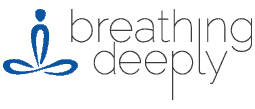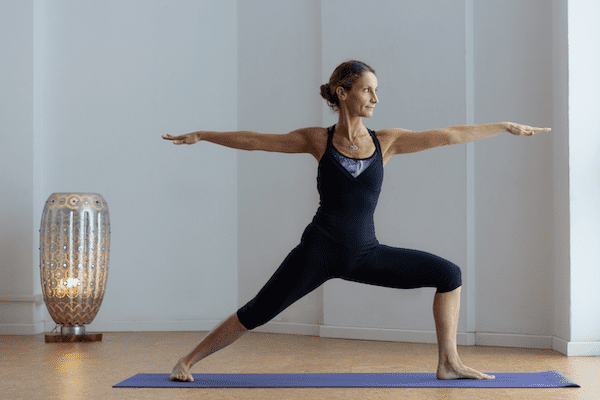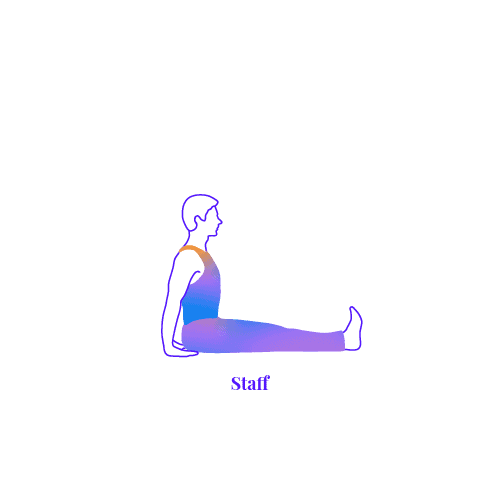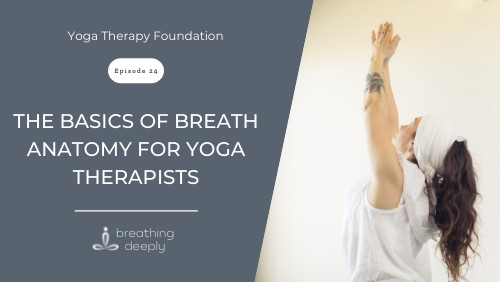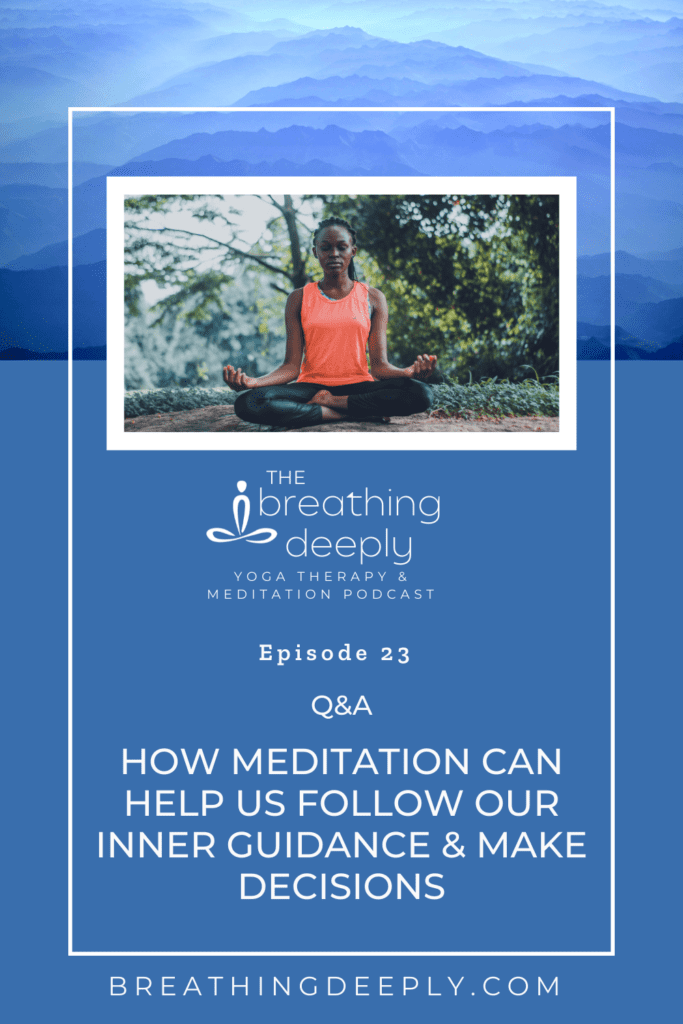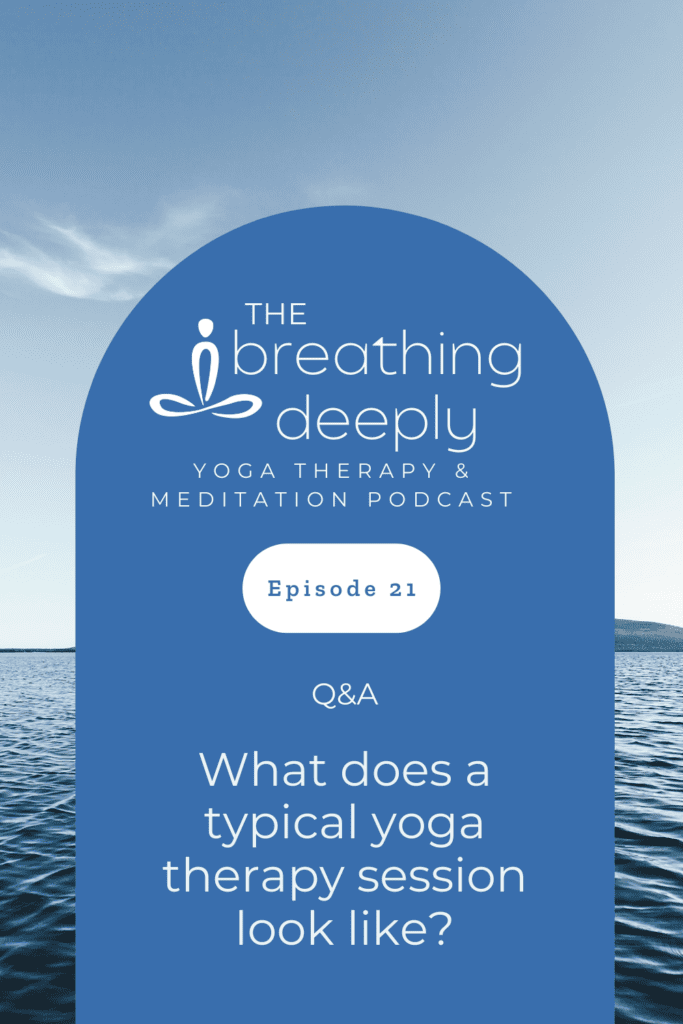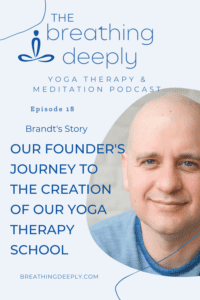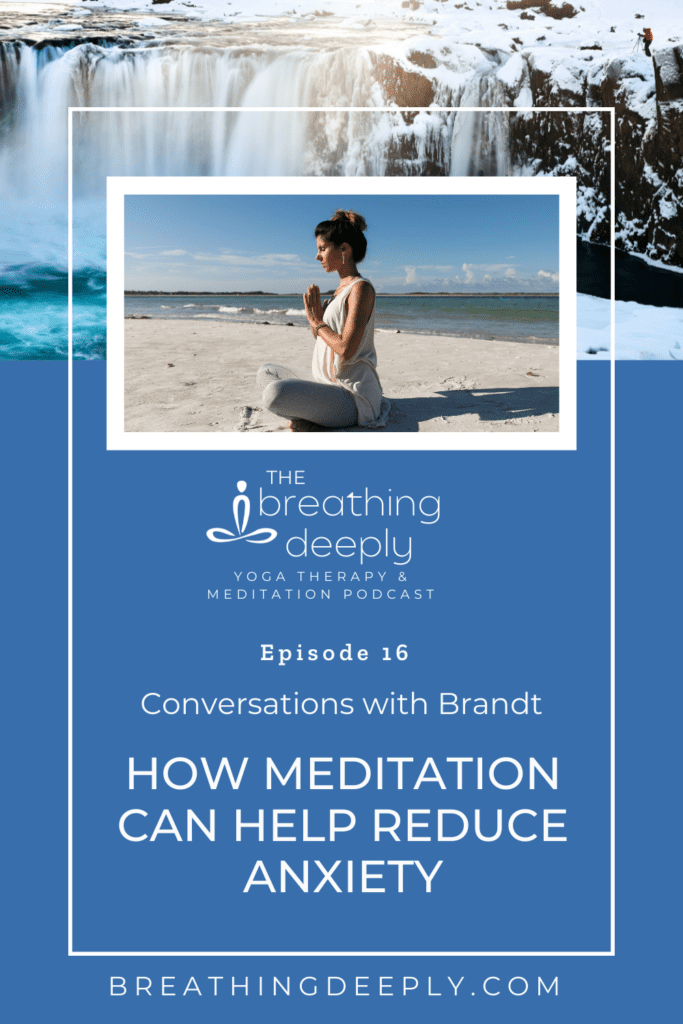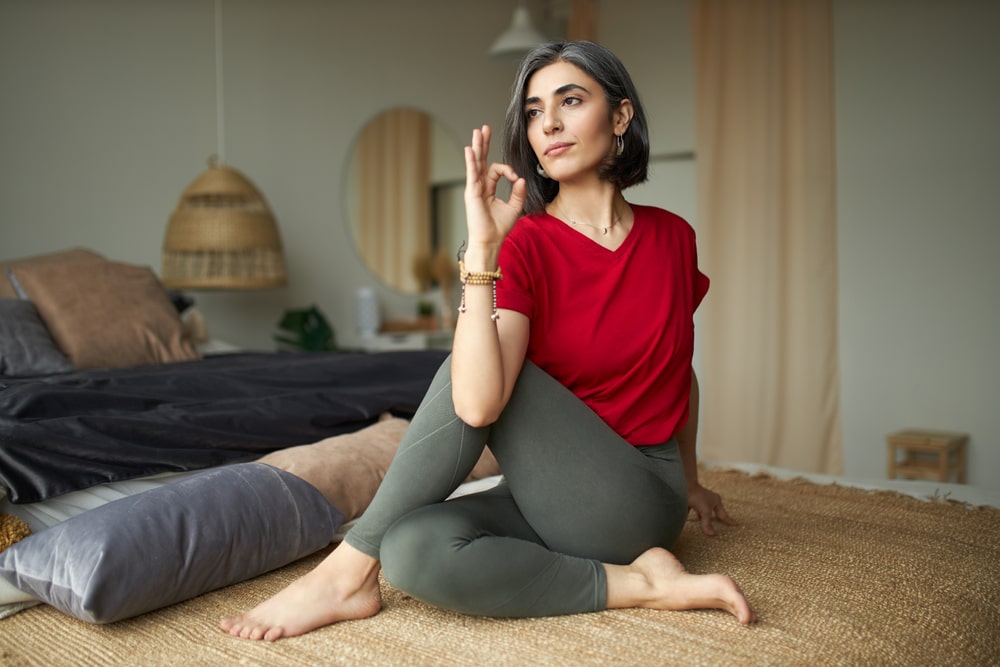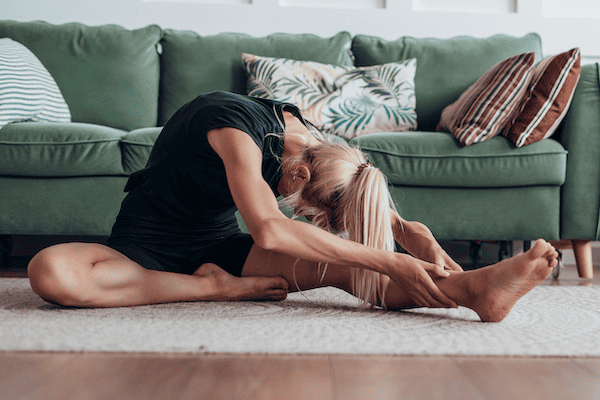
People aren’t made to sit all day, but nowadays, many of us do. This can lead to Upper Cross Syndrome, discussed in a previous blog post, which impacts your upper body and can cause pain in your neck, shoulders, chest, and upper back. It can also result in Lower Cross Syndrome, which affects your lower body and usually causes lower back pain. Fortunately, with the right Lower Cross Syndrome yoga techniques, most people are able to overcome this issue.
I’m Brandt Passalacqua, the Co-Founder and Lead Teacher of Breathing Deeply Yoga Therapy. My mission is to make therapeutic yoga techniques more accessible to others. Whether you have this syndrome yourself or simply want to help clients who have it, keep reading to learn more about this condition, its causes and symptoms, and how to use yoga for Lower Cross Syndrome.
If you’re ready to go further, those who are suffering from Lower Cross Syndrome are welcome to seek one-on-one help online from myself or another yoga therapist I’ve trained. Those who want to learn to help others heal with yoga are encouraged to look into our yoga therapy training programs.
Table of Contents:
- What Is Lower Cross Syndrome?
- What Causes Lower Cross Syndrome?
- Lower Cross Syndrome Symptoms
- How to Fix Lower Crossed Syndrome
- Benefits of Yoga for Lower Cross Syndrome
- 8 Yoga Poses for Lower Cross Syndrome in Sequence
- How Long Does It Take to Fix Lower Cross Syndrome?
- Get Started with Lower Cross Syndrome Yoga Therapy
What Is Lower Cross Syndrome?
Lower Cross Syndrome (LCS) is a health condition characterized by an imbalance of muscle strength around the pelvic region. Some muscles are too tight while others are too weak. This particular pattern of lower body muscular imbalances can affect your posture and movement, which often results in pain or discomfort. Lower Cross Syndrome can range from a minor inconvenience to something that negatively impacts your daily life.
What Is Lower Crossed Syndrome?
As you may have guessed, Lower Cross Syndrome is also sometimes referred to as Lower Crossed Syndrome. Both are correct.
What Causes Lower Cross Syndrome?
In a technical sense, Lower Cross Syndrome is caused by the steady weakening and underuse of certain muscle groups and overworking or shortening of others. Common causes of these muscle imbalances include:
- Sedentary lifestyle
- Prolonged sitting
- Poor posture
- Long hours at a desk or computer
- Improper weightlifting
- Obesity
- Aging
- Pregnancy
Sitting for long periods of time tends to be a common denominator. When we sit for prolonged periods of time, it signals our brain to adapt. Our hip flexors get short and tight, as do our lower back muscles. At the same time, our abdominal muscles get weak, as do our glutes.

As you can see from the diagram above, the muscles across from the tight, shortened muscles become weak (that’s why it’s called lower cross syndrome).
Over time, this becomes a real issue. The lower back is over arched, which can cause back pain and disk issues. The chronically shortened hip flexors can put our hip joints into a position that eventually can degrade the integrity of the hip joints.
Which Muscles Are Overactive in Lower Crossed Syndrome?
As mentioned above, Lower Cross Syndrome is characterized by certain muscles being overactive. This overactivity results in muscle shortening and tightness. Notably, these muscles often include:
- Hip flexors (iliopsoas, rectus femoris, and tensor fascia latae)
- Hip adductor muscles (inner thigh and groin)
- Thoracolumbar extensors (erector spinae, multifidus, quadratus lumborum, and latissimus dorsi)
These muscles often become overactive as a result of compensation for other weaker muscles in the body. The tightness of these muscles can lead to an exaggerated lumbar curve and anterior pelvic tilt.
What Muscles Are Weak in Lower Cross Syndrome?
While Lower Cross Syndrome is accountable for certain muscles being overactive, it’s equally responsible for contributing to the underactivity, lengthening, and weakness of others. Some of these weakened muscles include:
- Trunk muscles (rectus abdominis, obliquus internus abdominis, obliquus externus abdominis, and transversus abdominis)
- Abdominal core muscles (transverse abdominis and internal oblique)
- Gluteal muscles (gluteus maximus, gluteus medius, and gluteus minimus)
In Lower Cross Syndrome, insufficient activation and underuse cause this group of muscles to lack strength, aggravating dysfunctional posture patterns.
Lower Cross Syndrome Symptoms
The main symptom of Lower Cross Syndrome is back pain. However, some individuals may notice other Lower Cross Syndrome symptoms, such as:
- Discomfort or stiffness in the hips and the lower back
- Tight hamstrings and back muscles
- Weakness and fatigue, particularly in the gluteal and abdominal regions
- Difficulty in standing up straight or standing for extended periods
- Changes in gait, such as a small shuffle-like or waddling walk
- Postural changes that feature an exaggerated lumbar curve and an anterior pelvic tilt (which can look like a protruding abdomen or buttocks)
The presence of these symptoms does not necessarily confirm a diagnosis of Lower Cross Syndrome. You (or your client) should always be evaluated by a medical professional for an appropriate assessment and treatment plan before starting any Lower Cross Syndrome yoga practices.
How to Fix Lower Crossed Syndrome

In an ideal world, we would just stop sitting all the time! But in the real world, it can be necessary to be able to sit for long periods of time.
Fortunately, Lower Cross Syndrome can be improved and, in many cases, resolved with a combination of stretches and lifestyle changes:
- Sit less. Many of us need to sit at a desk to work, but you can try taking more breaks, using a standing desk, and spending more time on your feet after work.
- Improve your posture. Learn how to align your body properly and get in the habit of using good posture when you stand, sit, and exercise. (To see how yoga can help with this, jump ahead!)
- Get more ergonomic. Pay attention to your desk or work station. Consider adjustable desks, supportive chairs, and other ergonomic equipment.
- Practice targeted exercises and stretches. Strengthen weak muscles and lengthen tight, shortened ones to combat Lower Cross Syndrome. (To see an example, jump ahead to the yoga poses for Lower Cross Syndrome I’ve outlined in a sequence.)
- Get active. Incorporate low-impact exercises like yoga into your routine. These activities can help in enhancing body stability, balance, and flexibility, while also helping you lose weight and be less sedentary.
- Maintain a healthy weight. Regular exercise, a balanced diet, and healthy habits can help shed excess pounds, reducing pressure on the lumbar spine.
Understand that each individual’s recovery process will differ. If you’re wondering how to fix Lower Cross Syndrome, keep in mind that what works best for one person may not work for you (or your client). One of the benefits of yoga for Lower Cross Syndrome is that it can be personalized.
Benefits of Yoga for Lower Cross Syndrome
Yoga was born out of a meditation tradition. Guess what you do when you meditate all day? You guessed it: sit! This means that the yoga tradition has very reliable and longstanding techniques to prevent sitting from becoming a problem.
Consider these benefits of yoga for Lower Cross Syndrome:
- Take a personalized, holistic approach. Yoga encompasses a wide range of techniques beyond just yoga poses (asanas), also including pranayama (breathing exercises), meditation, and more. It also addresses more than just physical health, improving mental, emotional, and spiritual health as well. This tends to make it a more holistic approach than Western medicine, and it can be tailored to the person at hand, especially when working with a yoga therapist.
- Strengthen weak muscles. There are many yoga poses that target your abs and glutes, helping to strengthen them and counteract Lower Cross Syndrome.
- Stretch tight muscles. Similarly, there are plenty of yoga poses for Lower Cross Syndrome that stretch and lengthen tight muscles in your hips and lower back. This can increase your flexibility, which helps to support good posture. Pranayama, or breathing exercises, can also help change your nervous system response, allowing tight muscles to stretch easier.
- Improve posture. Regularly practicing yoga techniques, such as asanas, pranayama, and meditation, can increase your awareness of your body’s position, motion, and equilibrium. Many yoga poses also teach you proper alignment for your body. Together, this enables you to improve your posture as you recognize poor alignment and know how to fix it. Longer, slower movements in yoga can also help to hydrate and reshape your fascial structure so it’s easier to maintain good posture.
- Support habit change. Yoga can help you to form new patterns and regulate, both of which support habit change. For those with LCS, this can help with sticking to an exercise routine, maintaining better posture, and committing to healthy eating habits.
- Increase activity. A sedentary lifestyle can easily lead to Lower Cross Syndrome. Not only does yoga allow you to target the muscle groups affected by LCS, but also it gets you active and moving, which can help combat Lower Cross Syndrome in general.
- Lose weight. Obesity can contribute to Lower Cross Syndrome, putting extra pressure on your lumbar spine. Yoga can help with weight loss in a variety of ways, such as supporting habit change, improving mindfulness, increasing mobility, and reducing stress.
- Reduce stress and anxiety. Many yoga poses promote relaxation and stress relief, which can further help alleviate muscle tension, a notable symptom of LCS.
8 Yoga Poses for Lower Cross Syndrome in Sequence
Everyone is different, with their own medical history, health conditions, lifestyle, and goals. That’s why it’s so important to work with a yoga therapist who can develop a personalized and therapeutic approach for you to use yoga for Lower Cross Syndrome.
In general, however, Lower Cross Syndrome yoga techniques will involve strengthening your weak muscles (glutes and abdominals) and stretching your tight muscles (hip flexors and lower back erectors). I’ve shared an example of 8 yoga poses for Lower Cross Syndrome in sequence, which can be practiced in between sitting sessions. Also, feel free to break this sequence up during the day if that’s the only way to fit it in.
1. Squats (Malasana)

A great Lower Cross Syndrome yoga pose to start with is Malasana, also known as the Squat Pose. This posture, when performed right, can help strengthen the gluteal muscles and stretch the groin and hip flexors.
- Stand tall with your feet slightly wider than hip-width apart. Angle your toes outward.
- As you exhale, lower your body into a squat, going as low as it feels comfortable. Aim to get your hips at knee level or lower.
- Hold your arms straight out in front of you or clasp them together in front of your heart. Keep your chest lifted and your spine long. Engage your core muscles.
- As you inhale, raise your body into a standing position.
- Repeat 6 to 10 times.
2. Plank Pose on Forearms

This variation on Plank Pose is a full-body exercise that engages multiple muscle groups at once. Particularly, it is instrumental in strengthening the deep core muscles (transverse abdominis), the exterior abs (rectus abdominis), and the internal obliques, all of which are often weak in people with Lower Cross Syndrome. This pose can help improve strength, endurance, and postural stability, all of which are critical for managing and treating LCS.
- Lie down on your stomach with your arms under your shoulders and your palms flat on the mat beneath you.
- Lift your body up so you’re resting on your forearms, keeping your shoulders directly above your elbows.
- Keep your back straight and engage your core muscles, lifting your navel towards your spine.
- Hold until you feel fatigued, then drop down to rest on your belly.
3. Half Locust Pose with Bending Knees

Locust Pose is a prone, back-bending pose that’s excellent for strengthening the back of the body. In particular, it targets the muscles that maintain upright posture—namely, the erector spinae and the multifidus. The pose also stretches the hip flexors, which can be overly tight in those with Lower Cross Syndrome. By lifting and bending one leg at a time in the Half Locust Pose, you target the muscles in your lower back, glutes, and thighs.
- Lie flat on your stomach with your legs extended back and your arms at your sides.
- As you inhale, lift your right leg up behind you, holding it straight.
- As you exhale, bend your right knee at a right angle, with your foot toward the ceiling.
- As you inhale again, extend your right leg again so it’s straight.
- As you exhale again, release your right leg, letting it rest again on the mat.
- Repeat 3 to 6 times on each side, alternating right and left.
4. Child’s Pose

Child’s Pose is a restful pose that offers a gentle stretch to the hips, thighs, and ankles while releasing tension in the lower back and neck. It’s an effective pose for alleviating tightness and discomfort stemming from Lower Cross Syndrome.
- Kneel down on your mat with your big toes pointed inward, touching each other.
- Separate your knees about as wide as your hips, or as close as you comfortably can.
- As you exhale, drop your torso between your thighs and extend your arms in front of you, palms down on the mat.
- Bring your forehead to the mat and gently pull your hips down towards your heels.
- Hold for 6 breaths.
5. Runner’s Lunge

After resting in Child’s Pose, you can use Runner’s Lunge in your yoga for Lower Cross Syndrome sequence to stretch the hip flexors, particularly the psoas, which tends to be tight in those with Lower Cross Syndrome. The pose also helps in strengthening the gluteus muscles, enhancing lower body stability.
- Kneel down on your hands and knees.
- Step one foot forward between your hands. This foot should be directly under your knee, creating a 90-degree angle.
- Slide the back leg so it’s extended behind you.
- Keep your fingertips on the mat, or you can put your hand on the thigh of the forward leg. Feel the stretch in your quads.
- Hold for 6 to 10 breaths, then repeat on the other side.
6. Head-to-Knee Pose

A seated forward bend, Head-to-Knee Pose is another great yoga pose for Lower Cross Syndrome. It enables a deep stretch in the hips, hamstrings, and lower back, where tension often accumulates. By focusing on one side of the body at a time, it helps isolate these muscles for a better stretch.
- Sit on your mat with your legs extended straight out in front of you.
- Bend one knee to the side, and place the sole of your foot against the inner thigh of the stretched leg.
- As you inhale, raise your arms above your head, lengthening the spine.
- As you exhale, bend forward from your waist over the straight leg, reaching with your hands to hold your foot, ankle, or leg.
- Hold for 6 to 10 breaths, then repeat on the other side.
7. Rolling Bridge Pose

Bridge Pose is a powerful Lower Cross Syndrome yoga pose because it strengthens the back of the body while also stretching the hip flexors and chest. With this rolling variation, you can incorporate more movement and corresponding breath than if you held a stationary Bridge Pose.
- Lie flat on your back, with your knees bent and your feet flat on the mat, hip-distance apart.
- Place your arms flat on the mat along your torso with your palms down.
- As you inhale, press your feet into the mat and raise your hips, rolling your spine off the floor. Be sure to keep your knees directly above your ankles.
- Hold your thighs parallel to the mat if you can, engaging your glutes and leg muscles.
- As you exhale, lower your hips back down onto the mat, keeping your knees bent.
- Repeat 6 to 10 times.
8. Savasana

Savasana, also known as Corpse Pose, is a common way to close a yoga sequence. It encourages your body to rest and absorb the benefits of the Lower Cross Syndrome yoga poses that came before it. For those with LCS, this can be a great way to reduce muscle tension and increase bodily awareness. Although it may look straightforward and passive, Savasana is an intentional pose that fosters mindfulness, relaxation, and a stronger mind-body connection.
- Lie supine on your back, with your arms comfortably by your sides and your legs comfortably extended.
- You may want to close your eyes.
- Take a deep breath, and as you exhale, allow your body to relax completely into the yoga mat. Notice how each part of your body feels, releasing any tension you notice along the way.
- Hold this pose for 1–3 minutes.
How Long Does It Take to Fix Lower Cross Syndrome?
The amount of time it takes to effectively treat and potentially fix Lower Cross Syndrome depends on a variety of factors, including
- The severity of the condition
- How well you follow your treatment regimen
- How consistently you work on your posture
- Whether lifestyle changes need to be made and are followed
- Your overall health
In my experience, many people can make a lot of progress within 8 weeks of practicing yoga for Lower Cross Syndrome.
It’s important to be patient and persistent. Lower Cross Syndrome is commonly caused by poor habits accumulated over years, and correcting these patterns takes time. The goal should not be to rush through the process but to achieve a sustainable improvement in posture and other supportive habits.
How to Sleep with Lower Cross Syndrome
If you experience discomfort trying to sleep with Lower Cross Syndrome, consider sleeping flat on your back if that’s a suitable option for you. This can allow your hip flexors to not be as shortened while you’re sleeping. But this is not necessary in order to treat or overcome LCS.
Get Started with Lower Cross Syndrome Yoga Therapy

Are you interested in Lower Cross Syndrome yoga therapy? I have personally helped numerous clients work through this condition, and I also teach my yoga therapy students how to address common issues like this one. Sign up to work online with myself or a yoga therapist I’ve trained if you have LCS, or check out our yoga therapy training if you want to work with LCS clients yourself.
